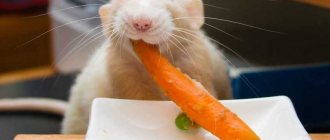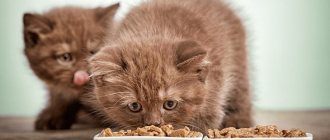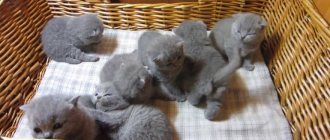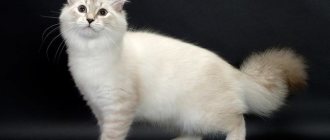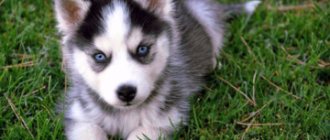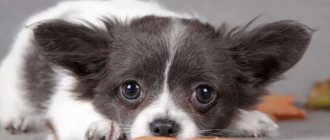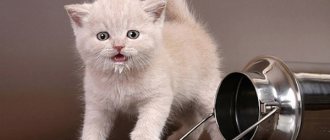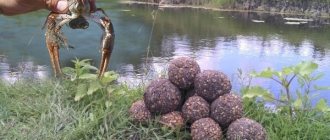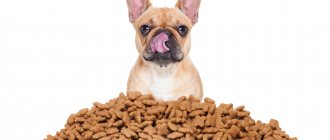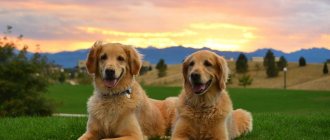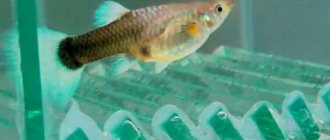Breed Features
Kurilian bobtails have a unique and different appearance from all others. A characteristic feature of the breed is a short, deformed tail (from 2 to 8 vertebrae).
The homeland of these animals is the Kuril Islands Iturup and Kunashir. Breeders quickly found out that a short tail is passed on from parents to children and does not carry genes dangerous to health and life, so already in 1991 the first breed standard was adopted.
Kurilian Bobtails are divided into two groups: shorthaired and semi-longhaired. In the first case, the cat's fur is short in length and the outer coat is well developed. The undercoat of short-haired representatives is not very thick. In semi-long-haired animals, the outer hair is poorly developed, but there is a rather thick and dense undercoat.
INTERESTING! Disqualifying faults and serious shortcomings of the Kuril Bobtail are: short (up to 3 cm) or too long (more than 12 cm) tail, very curved back, some colors (cinnamon, fawn, chocolate, lilac).
Kurilian Bobtails are very sociable and friendly cats. Their habits are a little similar to dogs. Many cats happily run after an abandoned toy. Also, some bobtails walk well on a harness.
External standard
According to the accepted external standard, bobtails from the Kuril Islands must have the following characteristics:
The head is large with a wedge-shaped muzzle, narrowed at the bottom.
The eyes are medium in size, the upper part of the eye is oval, the lower part is rounded. Located from each other at a distance equal to the size of one eye. The color depends on the coat color; different colored eyes are possible.
The ears are medium in size, triangular in shape, ending in a slight curve. They have a distinctive feature - a slight forward tilt angle. Tassels are allowed on the ears.
The nose is medium in size, quite wide, straight in shape.
The bones and muscles are powerful and well developed.
The paws are rounded towards the bottom.
The coat can be presented in several options:
Short hair over the entire surface of the body with a medium-developed undercoat. It is soft, velvety to the touch, resembling the fur of exotic cats or British cats.
Semi-long coat with medium undercoat, forms fluffy pants, collar and socks. With this option, the tail should be very fluffy.
The tail might look like this:
Panicle. The tail consists of several vertebrae, according to the standard from 5 to 13, has creases and reaches a length of less than 14 cm.
Stump. A shortened tail of 2–8 motionlessly fused vertebrae reaches a length of approximately 5 cm.
Spiral. It is considered the most luxurious tail option. It is twisted in the form of a ring and can have a fairly decent length. The number of vertebrae ranges from 5 to 10.
The external standard must be strictly observed in the case of registration of a pedigree or participation in an exhibition.
Choosing a place and dishes
The main requirements for cat dishes: stability and sufficient capacity. The Kurilian Bobtail should have at least two bowls. Food is placed in one of them, and clean, fresh drinking water is poured into the other every day.
Cat dishes are made from different materials:
- Plastic. This cookware has the lowest cost. It is light and washes well. Plastic bowls come in a variety of shapes and colors. Some plates come with a special stand that resembles a tray. It protects the floor from food that the bobtail might pull out of the bowl.
- Metal. Stainless steel bowls are durable and easy to clean. There are several varieties of such containers on sale: with a stand, with anti-slip rubber, etc.
- Ceramics. These bowls are quite heavy and fragile and can break if dropped. But this dishware has an advantage - it does not impart any foreign taste or smell to the water and food. Due to their weight, ceramic bowls do not roll all over the floor. There are plates on sale in a variety of colors, many with attractive and funny designs.
The height of the sides of the bowl is very important. For dry food, it is better to use deeper and more capacious dishes. For natural food or canned food, bowls with low sides are more suitable. In both cases, the base must be wide enough.
An oval or round bottom shape is most preferred, as square or other shaped plates may be uncomfortable for the kitten.
REFERENCE! Another rule is that each type of food should have its own bowl.
When choosing a place and dishes, it is necessary to take into account the breed characteristics. Kurilian Bobtails are very sociable, so the plates should be placed in a common kitchen, where the kitten will eat together with the owners. You should not move your animal’s bowls around the house; the place for them should be stationary.
It is better to place cat dishes on a special mat or tray. Wash bowls separately from human plates and mugs. You should not use detergents for this, just use a sponge and hot water.
Natural diet
A menu consisting of natural products should be varied and well-designed. The basis of the diet is meat. It is a source of protein that is perfectly absorbed by the cat's body. In the diet, this product takes up up to 60% of the total daily requirement.
The meat is given to the kitten raw, but it must first be thoroughly frozen in order to destroy possible parasites. The Kurilian Bobtail can be offered veal, rabbit, turkey, and chicken.
From three months onwards, a kitten’s menu can include various offal products:
- Liver. This product helps normalize digestion. If your pet is constipated, give him raw liver, because... it has a laxative effect. If you have loose stools, you can offer your bobtail liver that has been thermally treated (stewing, boiling, baking). When cooked, this offal strengthens a little.
- Heart. It is recommended to offer it to your pet raw. Kittens happily eat small and unshredded chicken hearts.
- Tripe, udder, lung. It is better to boil these products first, because... in their raw form they are less digestible.
- Kidneys. This offal is pre-soaked in cold water. Kidneys are given to kittens scalded.
REFERENCE! From the age of 3 months, the Kurilian Bobtail begins to be offered fish. It is worth giving preference to marine varieties (flounder, salmon, tuna, etc.). The fish is pre-cooked and the bones are removed from the fillet.
The kitten gets fats from vegetable oil (preferably olive oil), quail or chicken egg yolk, and cream.
From dairy products, you can offer your kitten cottage cheese, kefir, yogurt, acidophilus (without sugar), narine, fermented baked milk. Also, once or twice a week, the pet is offered low-fat (up to 15%) sour cream and cream.
Many Kurilian Bobtails are happy to eat natural yoghurts, but they should not contain any extraneous additives or sugar. The share of fermented milk products in your pet’s diet is up to 15% of the daily requirement.
A cat's diet must include plant foods, because... it is a source of carbohydrates. The pet is offered cereals (buckwheat, rice, oatmeal). Their amount should not exceed 20% of the daily value. Vegetables are given to the kitten: carrots and cauliflower. You don’t have to give your Kurilian Bobtail fruit, but some pets themselves happily eat bananas, apples, pears, etc.
Wheat sprouts are beneficial for kittens, but they begin to be included in the pet’s menu only after he is 3-4 months old. This product is rich in vitamins and minerals and helps remove toxins from the bobtail’s intestines. The sprouts also have a slightly laxative effect.
Meat delicacies
Adding meat products to your diet should be approached responsibly.
There are a number of “holy” truths that should be followed for the proper growth and development of the baby:
- Meat and fish products can only be given boiled.
- The serving should be small pieces, preferably in the form of minced meat.
- Under no circumstances should you give meat every day. Alternate foods.
- It is better to completely exclude pork from the menu, as well as liver and giblets.
- Chicken and turkey liver are allowed in limited quantities.
Ready-made feed
Dry food makes caring for the Kurilian Bobtail much easier. This product provides a growing kitten with all the nutrients it needs. Crackers can sit in a bowl all day without spoiling and are suitable for consumption.
Ready-made feeds have different qualities and are divided into four types:
- Holistic. These products are of the highest quality. The main component is fresh and dehydrated meat; in some lines fish is used instead. Carbohydrates are represented by easily digestible grains and vegetables (rice, potatoes, carrots, lentils, etc.). Almost all holistic formulas contain pro- or probiotics, which improve the kitten’s digestion. The following producers are more popular among breeders: Farmina, Acana, Grandorf , etc.
- Superpremium . This product is suitable as the main menu for a Kuril Bobtail kitten. The source of protein is dry dried meat. The animal receives carbohydrates from cereals (rice, wheat) and vegetables. The product also includes dried berries and fruits. The most popular brands: Savarra, Fitmin, Organix, Brit Care , etc.
- Premium The quality of such products is slightly worse than that of super premium feed. Sources of animal protein include both dried meat and offal. Carbohydrates in most premium foods are represented by inexpensive cereals (corn and its derivatives). The product is enriched with mineral and vitamin supplements necessary for the kitten. Popular brands: Brit Premium, Sheba, Cat Chow, Our Mark , etc.
- Economy Products from this group are of the worst quality. The main ingredient is cereals (corn and its derivatives, wheat, etc.). There is little animal protein in such feeds, and their sources are by-products and various waste remaining after carcass processing. The most popular foods: Darling, Whiskas, Oscar, Trapeza, etc.
Sample menu by age
Kurilian Bobtails eat 2 to 5 times a day. This figure directly depends on age. Babies up to 2 months eat more often; during this period they need to eat up to 4-5 times a day. By six months, the pet is gradually transferred to three feedings a day, and by a year - to twice a day.
We offer an overview of a sample menu by age for kittens and adolescents of the Kuril Bobtail.
Up to a month
Until the age of one month, the baby must be with his mother at all times. Bobtails begin to be fed at 3 weeks. To do this, use raw, pre-frozen and very finely chopped meat; turkey and rabbit meat are best suited.
Also, as a first complementary food, you can use low-fat cottage cheese without sugar and other additives harmful to the bobtail. The main rule is that food for one-month-old babies should be very soft.
1 month
At 1 month, the kitten continues to eat mother's milk, but also begins to eat other foods more actively. The basis of the diet is meat.
- A small Kurilian bobtail is given up to 50 grams of this product per day.
- The pet is also offered cottage cheese, yogurt, bifidok, fermented baked milk and other fermented milk products in the amount of 10-15 grams per day.
2 months
At 2 months, the Kuril Bobtail menu expands slightly. A pet eats up to 150-180 grams of food per day.
The menu consists of the following products:
- Meat (rabbit, turkey, veal, etc.) – up to 60 gr.
- Fermented milk products – up to 80 g.
- Cereals – up to 40 grams in finished form.
- Vegetables – up to 20 gr.
At this age, the pet begins to be introduced to vegetables and cereals. They are added to the bowl little by little so that the stomach gets used to the new type of food.
3 months
At this age, small Kuril Bobtails begin to go to new families. Their diet at 3 months consists entirely of
- meat and offal (up to 60-70 grams);
- cottage cheese and other fermented milk products (up to 70 g);
- cereals (up to 50 g boiled);
- vegetables (up to 30 g).
At this age, children begin to be introduced to fish. It is given to the bobtail only in boiled form, and it is better to give preference to marine species. The bones from the fish must be removed, as a small kitten can easily choke.
4-6 months
At this age, the small pet eats all the foods that adult Kuril Bobtails also eat. The total amount of food per day is 250-280 grams, and the number of feedings is reduced to three.
At 4-6 months, the kitten should receive:
- meat and offal – up to 100 g;
- cottage cheese and other fermented milk products – up to 120 g;
- fish – up to 60 g (no more than 2 times a week);
- cereals and porridges in water – up to 70 g;
- vegetables – up to 40 g;
- egg yolk – 1 pc. in Week.
ATTENTION! At this age, the pet begins to be offered a chicken egg. It can be replaced with quail eggs in a ratio of 1 to 6. This product is given to the Kurilian Bobtail no more than 1-2 times a week.
From 6 months to 1 year
At this age, the pet has already reached its maximum size. Its diet is practically no different from the menu of adult Kuril Bobtails. A medium-sized kitten should receive up to 230 grams of food or 3-5% of its weight per day.
Vitamins and supplements
Pets that eat only natural foods need additional vitamins and supplements.
The following drugs can be included in the menu:
- Beaphar Kitty's Junior. These tablets have a fishy aroma, so kittens actively eat them on their own. The drug is produced in the Netherlands. The composition includes vitamins B, H and PP. Tablets can be given to babies from 6 weeks in a dosage of 8 pieces. for every kilogram of body weight.
- Gimcat (GimCat) Baby Tabs. This drug is produced in Germany. The composition includes mineral supplements such as taurine, calcium, vitamins (A, D3, E, group B, K3), nicotinic acid, L-carnitine. The pink tablets contain fruit, and the green tablets contain seaweed. A pet is given up to 10 pieces per day.
- Farmavit Active . This drug is produced in Russia. It normalizes metabolic processes, replenishes enzyme deficiency in the gastrointestinal tract, and maintains the balance of vitamins and microelements. The composition includes substances such as taurine, phosphorus, calcium, rutin, vitamins (group B, A, D3, E, H). The tablets are given in courses of 30 days, with a break of 6-8 weeks between them. Dosage: babies up to 3 months – half a tablet; after 3 months – a whole tablet.
- Veda (VEDA) Biorhythm. This drug is produced in Russia. They start giving it to kittens that are already 2 months old. The pet is fed 2 tablets per day: one in the morning, the second in the evening. The morning tablet contains substances that improve digestion, strengthen the nervous system, and stimulate the immune system. The evening tablet includes components that promote tissue and coat growth, cleansing the kidneys and liver. The drug is given to Kurilian bobtails for 24 days. If necessary, the course can be repeated after a week.
Water and drinking regime
With any type of feeding, the Kuril Bobtail should have free access to water at all times. A pet drinks up to 250-300 ml of liquid per day, but animals that eat natural products can drink 50-60 ml less.
An animal can drink poorly for various reasons. The kitten may not like the container in which the water is poured. Many bobtails prefer deep, stable dishes made of ceramic or glass.
REFERENCE! If the level of liquid in the bowl remains virtually unchanged, your kitten may have found another source of water.
Hunting character
Representatives of the Kurobob breed are distinguished by their pronounced hunter behavior. Cats can jump high and far; nature has endowed them with strong hind limbs.
Short-tailed Kurilian Bobtail
It was their hunting habits that endowed these cats with special intelligence and curiosity. Bobtails are highly trainable and even trainable.
Animals easily adapt and get used to any place of residence.
The cohabitation of a lynx cat with birds and small rodents (rats, hamsters) should be monitored: it preys on such pets. She can easily make friends with a dog if the latter is not aggressive.
Be sure to read:
Description of the Chinchilla cat breed - character, habits, hygiene and grooming of this beauty
What not to feed a Kurilian Bobtail kitten
Many foods are prohibited for cats as they can be harmful to the pet's health.
Here's what you shouldn't feed your Kuril Bobtail kitten:
- chocolate and sweets;
- alcohol in any form, incl. hop-containing drinks;
- drinks containing caffeine (especially green tea and coffee);
- some vegetables (legumes, broccoli, potatoes, tomatoes, garlic);
- some fruits (avocados, grapes, stone fruits, raisins);
- milk, especially cow's milk;
- spices and more salt;
- bakery products and other pastries made from selected first-grade wheat flour.
Feeding the Kurilian Bobtail throughout its growth is a very important issue. An incorrectly composed diet will lead to improper development of the baby and will not provide his body with the necessary minerals, trace elements and vitamins.
Prohibited Products
It is important to exclude prohibited foods from the Kuril Bobtail kitten’s diet:
- Bones, pure fat, skin, especially poultry.
- Palm oil.
- Grapes, raisins.
- Juicy and sweet fruits.
- Soy.
- Mushrooms.
- Corn and semolina.
- Raw freshwater fish.
- Dry, salted fish.
- Products containing sugar or its substitutes, xylitol (chewing gum, some sweets), flour or yeast, caffeine, cocoa, any stimulants (sweets, tea, coffee, chocolate), marinades, salt, spices.
- Smoked products, including sausages, balyki, fish.
- Expired products.
- Leftovers from the table.
Controversial foods in the diet of a Kuril Bobtail kitten are:
- Fresh pork is a source of helminths and false rabies.
- Raw ocean fish are a source of helminths.
- Whole milk – risk of individual intolerance.
- Chicken eggs are an allergen.
- Factory-bred chicken – risk of allergies and individual intolerances.
- Raw and boiled chicken liver in large quantities.
- Cereals.
Almost all controversial products are beneficial for your pet, but when introducing them into the diet you need to act wisely . Products that can become sources of parasites must first be boiled or frozen for 4–5 days. Products to which a kitten may be allergic should be introduced into the diet in small quantities, monitoring the body's reaction.
